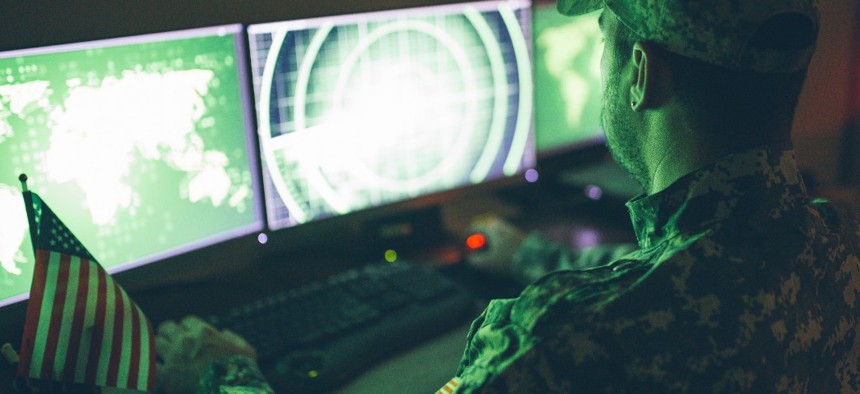Russia’s Ukraine Invasion Makes DOD Tech Officials Ask ‘Are We Postured for That Kind of Fight?’

Milan_Jovic/Getty Images
Data is driving insights around this modern conflict.
As Russia’s unprovoked, large-scale invasion of Ukraine escalates, officials within the Defense Department and its components are making new considerations around their strategic and technology-centered priorities, through the lens of the fresh conflict.
“So, one of the most interesting things about what's happening in that area of the world right now is that everyone's watching. They are seeing, real-time, how this unfolds and it's not just the media that's presenting it to us. It's everybody. And so, a lot of things were easily predicted, if we were watching patterns-of-life—and that's something that we do as an Army,” Cynthia Bedell, director of the Army Research Laboratory Computational and Information Sciences Directorate explained.
Pattern-of-life analysis is a surveillance technique conducted to understand a subject's or community’s behavior. As Bedell demonstrated on the topic of Ukraine, the Army Research Lab is interested in tools and capabilities that can provide early warnings when patterns-of-life in part of the world change.
She provided this insight on a panel alongside Department of the Navy Chief Data Officer Tom Sasala during the Intelligence Summit co-hosted by Defense One and Nextgov, which aired on Thursday. Among other topics, the panelists discussed how they were thinking about the unfolding invasion from their professional perches.
“One of the realizations I guess I've had, because of Ukraine and some of the other world dynamics, is we have to have the ability to support highly episodic scenarios. And so our reaction to Ukraine—in large part from my perspective at the Secretariat level—is more of a readiness position, right? Are we postured for that kind of fight tonight, or fight tomorrow, sort of war? It's not so much what the [Combatant Commands] are doing,” Sasala said. “So the kind of epiphany that I had is, we should probably have some enduring capability—reserved capacity—for episodic events in the world that we can respond to very quickly.”
As it embarks on what the CDO called a “kind of data transformation,” the Navy is establishing a data management program with the ultimate goal of using digitally-driven insights to inform operational effectiveness.
“Honestly, the way that we responded to the situation in Afghanistan not so long ago, as well as Ukraine, is we just stopped doing something else and we start doing this. And that may be appropriate, depending on what we're doing. But in many cases, it's not,” Sasala said. “So having those tools in place, having the procedures in place and not just throwing out the security manual and saying, you know, ‘the heck with all that we're just gonna do it because we have to because the world's imploding.’”
Though he didn’t get into specifics, Sasala confirmed that his military branch is gathering data “on the backside” that may “feed the questions and answers” associated with what’s unfolding in Ukraine.
Beyond pattern-of-life analysis, Bedell also mentioned that the Army Research Lab is highly interested in how cyber and disinformation are playing a key role in this effort.
“That's a huge mission for us: cyber defense,” she noted.
While ARL does not lead offensive cybersecurity operations, insiders collaborate with those that do.
“So there's another entity in the Army that looks at how to cause effects in a region. But, just watching that and watching the non-military volunteers going over to thwart some of the aggressors' cyber effects—it's been absolutely fascinating to watch. How do we continue to shape what independent actors are doing, so that it affects us in the right way,” Bedell said. “And so those are kind of the two big things for me, the early warning from patterns-of-life, and then how do we harness all of these volunteers that have skills—that we don't necessarily have as much in the Department of Defense—how do we harness them, use them, affect their enthusiasm and help them shape what they're doing, so it is something that we can respond to and use once we reach a steady state and can go back to a peaceful state?”
NEXT STORY: Hidden Security Considerations When Moving to 5G




